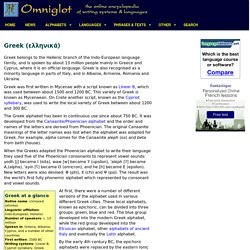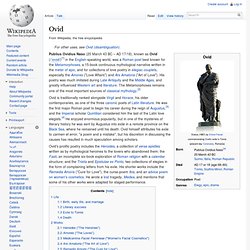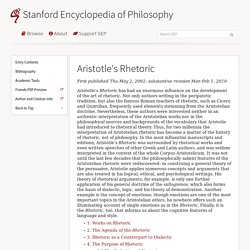

Rhetoric. Painting depicting a lecture in a knight academy, painted by Pieter Isaacsz or Reinhold Timm for Rosenborg Castle as part of a series of seven paintings depicting the seven independent arts. This painting illustrates rhetorics. From Ancient Greece to the late 19th century, it was a central part of Western education, filling the need to train public speakers and writers to move audiences to action with arguments.[4] The word is derived from the Greek ῥητορικός (rhētorikós), "oratorical",[5] from ῥήτωρ (rhḗtōr), "public speaker",[6] related to ῥῆμα (rhêma), "that which is said or spoken, word, saying",[7] and ultimately derived from the verb ἐρῶ (erō), "say, speak".[8] Uses of rhetoric[edit] Scope of rhetoric[edit]
Longinus, On the Sublime, tr. W. Rhys Roberts, at Peitho's Web. Greek alphabet, pronunciation and language. Greek belongs to the Hellenic branch of the Indo-European language family, and is spoken by about 13 million people mainly in Greece and Cyprus, where it is an official language.

Greek is also recognised as a minority language in parts of Italy, and in Albania, Armenia, Romania and Ukraine. Greek was first written in Mycenae with a script known as Linear B, which was used between about 1500 and 1200 BC. This variety of Greek is known as Mycenaean. Poetry In Translation - A.S. Kline's Free Poetry Archive - Main Site. Ovid. Ovid is traditionally ranked alongside Virgil and Horace, his older contemporaries, as one of the three canonic poets of Latin literature.

He was the first major Roman poet to begin his career during the reign of Augustus,[3] and the Imperial scholar Quintilian considered him the last of the Latin love elegists.[4] He enjoyed enormous popularity, but in one of the mysteries of literary history he was sent by Augustus into exile in a remote province on the Black Sea, where he remained until his death. Ovid himself attributes his exile to carmen et error, "a poem and a mistake", but his discretion in discussing the causes has resulted in much speculation among scholars.
Life[edit] Ovid talks more about his own life than most other Roman poets. Information about his biography is drawn primarily from his poetry, especially Tristia 4.10, which gives a long autobiographical account of his life. Универзитет у Београду - Филозофски факултет. Poetics (Aristotle) The work was lost to the Western world and often misrepresented for a long time.

It was available through the Middle Ages and early Renaissance only through a Latin translation of an Arabic version written by Averroes.[5] Aristotle distinguishes between the genres of "poetry" in three ways: Matter language, rhythm, and melody, for Aristotle, make up the matter of poetic creation. Where the epic poem makes use of language alone, the playing of the lyre involves rhythm and melody. Subjects Method One may imitate the agents through use of a narrator throughout, or only occasionally (using direct speech in parts and a narrator in parts, as Homer does), or only through direct speech (without a narrator), using actors to speak the lines directly. Having examined briefly the field of "poetry" in general, Aristotle proceeds to his definition of tragedy: Tragedy consists of six parts which Aristotle enumerates in order of importance, beginning with the most essential and ending with the least:
Aristotle's Rhetoric. 1.

Works on Rhetoric According to ancient testimonies, Aristotle wrote an early dialogue on rhetoric entitled ‘Grullos’, in which he put forward the argument that rhetoric cannot be an art (technê); and since this is precisely the position of Plato's Gorgias, the lost dialogue Grullos has traditionally been regarded as a sign of Aristotle's (alleged) early Platonism. But the evidence for the position of this dialogue is too tenuous to support such strong conclusions: it also could have been a ‘dialectical’ dialogue, which listed the pros and cons of the thesis that rhetoric is an art. We do not know much more about the so-called ‘Technê Sunagogê’, a collection of previous theories of rhetoric that is also ascribed to Aristotle.
Cicero seems to use this collection itself, or at least a secondary source relying on it, as his main historical source when he gives a short survey of the history of pre-Aristotelian rhetoric in his Brutus 46–48. 2. The structure of Rhet. 3. 4. 5. 6. 7. 8. MARDEN9 TEXT. THESAURUS MUSICARUM LATINARUM School of Music Indiana University Bloomington, IN 47405 (phone: [812] 855-5471; Internet: mathiese@indiana.edu) Data entry: Bradley Jon Tucker Checked by: Angela Mariani Approved by: Thomas J.

Mathiesen Fn and Ft: MARDEN9 TEXT Author: Martianus Capella Title: De nuptiis Philologiae et Mercurii Source: Martianus Capella, ed. Adolfus Dick (Leipzig: B.